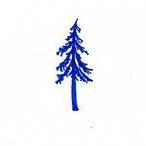
A wood chipper is a significant investment for any business and keeping your machine in peak working condition will save on unexpected downtime. Whilst servicing is very important, how much consideration do you give to transporting your wood chipper safely to the work site?
There are many variables on transporting your machine depending on the kind of wood chipper you own. Timberwolf, the UK’s leading wood chipper manufacturer, give their advice on best practice when towing your wood chipper to site and back home again safely.
Who can tow a wood chipper?
In the UK, anyone holding a full driving licence with a category B entitlement can drive a vehicle with a gross weight up to 3500kg and tow a wood chipper (or trailer) up to 750kg. It is an important consideration to include the weight of any fuel in your wood chipper within your allowance; all Timberwolf Sub 750kg wood chippers remain under this benchmark towing weight, even when full* of fuel.
It is possible for drivers with a category B entitlement to tow a wood chipper or trailer with a gross weight over 750kg, as long as the combined gross weight (maximum permitted weight) of the vehicle and trailed equipment does not exceed 3,500kg e.g. a vehicle with a gross weight of 2,500kg can tow a trailer with a gross weight of 1,000kg, a total gross weight (maximum permitted weight) of 3500kg.
For combined vehicle and trailer gross weights exceeding 3,500kg where the wood chipper (or trailer) weighs over 750kg, drivers are required to have a category B+E on their licence. Driving licences issued before 1st January 1997 had B+E entitlement automatically included, but individuals with licences issued after this date need to complete an additional car and trailer towing driving test to obtain the B+E entitlement. With a B+E entitlement your vehicle and trailed equipment weight must not exceed 7,000kg as the maximum vehicle weight is 3,500kg and the maximum weight of a trailer with overrun brakes is 3,500kg.
If your total vehicle and wood chipper/trailer gross weight exceeds 3,500kg (and is no greater than 7,000kg) a maximum distance of 100km as the crow flies from your work base is allowed without the need to adhere to a tachograph and UK Government Drivers’ hours rules.
Remember: If you are travelling with a full load of wood chip and/or timber, your combined vehicle and trailer gross weight will significantly increase.
Check your Towing Equipment
Just as you would check over your vehicle before a journey, you should check your wood chipper (or trailer) is road worthy.
Check the following items before driving on the road:
- Tyres are correctly inflated, have UK legal tyre tread (1.6mm across the central three-quarters of the tyre) and show no signs of damage.
- The lighting board is functioning correctly, including brake lights, reverse lights and indicators.
- The condition of the trailer or machine chassis shows no signs of excessive wear or cracking.
- The hitch, jockey wheel and breakaway cable are in good condition.
- The trailer ramps and securing points are in good condition.
- The latches to secure any panels or tailgates on the trailer are working correctly.
If you are using a trailer to transport your wood chipper, ensure it is legally capable of carrying the weight of your machine. Most trailers have a chassis plate attached declaring the maximum Gross Vehicle Weight (GVW). You should ensure your vehicle is capable of towing the wood chipper or trailer when fully laden. The towing vehicle GVW and the Gross Combination Weight (GCW) are stated on the chassis plate on the vehicle, the vehicle handbook and the V5C registration document. A towing vehicle with a maximum GVW of 3500kg can tow a trailer no larger than 7m long by 2.55m wide. Vehicles with a GVW over 3500kg can tow trailers up to 12m long by 2.55m wide.
Road tow wood chippers and trailers over 750kg are required by UK law to have their own brakes and a breakaway cable. Before setting off, ensure the brakes are in good working order and the breakaway cable shows no signs of damage. Should the trailed equipment become detached from the towing vehicle, the breakaway cable is designed to pull on the handbrake and bring the detached wood chipper or trailer to a safe stop. Before departure, always ensure the breakaway cable is correctly attached to the vehicle framework beyond the towing coupling.
Trailers and wood chippers under 750kg are not required to have brakes installed, which means only the towing vehicle brakes are used for stopping. In UK law, a securing cable or chain must be fitted and looped over the tow ball of the vehicle and is designed to keep the wood chipper or trailer loosely attached to the vehicle should the towing coupling fail. With no brakes on the trailing equipment, the only safe way to bring it to a controlled stop is by using the towing vehicle itself.
Remember: Ensure your breakaway chain or cable is short enough to prevent the nose of the trailer hitting the ground should it become detached from the towing vehicle.
Get Properly Hitched
You should load your wood chipper on a firm, level surface.
If you are towing your wood chipper with your vehicle, check the tow hitch is firmly latched into the hitch fitting. Most couplings have an indicator, so you should familiarise yourself with your towing set-up so you can easily perform a visual check. Once the latch is fully closed and latched on to the tow hitch, unwind the jockey wheel so you can provide an upward force to check the latch is secure. Clip-on the breakaway cable and plug in the lighting board cable, checking it is functioning correctly. Ensure the jockey wheel is wound up to the top position and clamped into place with the top rotating handle fully tight. Finally, ensure the hand brake on the wood chipper (if fitted) is fully off.
When loading a tracked wood chipper onto a trailer, it is recommended to reverse up on to the trailer bed with the operator riding or walking ahead of the machine.
There are two main reasons behind this:
- Loading the wood chipper in reverse means the feed funnel is pointed towards the rear and creates less wind resistance during towing.
- If the wood chipper slips on the trailer, the operator is positioned away from the direction of sliding machine.
The same hitching checks for a road tow wood chipper apply when using a trailer for your wood chipper. The notable exception to consider is the positioning of the wood chipper on the trailer; it should be centrally located from side to side with a positive nose weight and even weight distribution on the trailer axles. By first attaching the trailer to the vehicle then loading the wood chipper, you can check the height of the rear suspension on the towing vehicle and gauge good positioning of the equipment on the trailer. If there is too much weight on the rear of the trailer it will be impossible to tow safely. If there is too much weight on the front of the trailer it will place excess load on the tow hitch coupling and the rear axle of the towing vehicle. It can also cause the towing vehicle to have light steering, impaired braking and headlights that point dangerously high.
Once positioned on the trailer, ensure the wood chipper is securely strapped using suitable straps and tie-down points. Always use good quality straps of the recommended rated level, renewing them if they become damaged or frayed in any way.
Remember:
- Before departure, ensure your wood chipper is ready for transport
- Check the infeed chute is folded shut and securely latched
- Check the discharge rotation clamp is locked and in a safe orientation
- Check all other fastenings are secure.
- Ensure the trailer is correctly hitched, all lights are functioning correctly, the breakaway cable is correctly attached and the handbrake is fully disengaged
Keep your distance
When towing your wood chipper behind your vehicle you need to consider that its additional weight will extend your safe stopping distance. Ensure you leave enough space between you and the vehicle in front to account for your increased stopping distance. Not all wood chippers or trailers have their own brakes, so your stopping distance in these situations will be even greater. If you own a braked road tow wood chipper or trailer, check the brakes are working correctly before you take to the public roads.
Remember: The weight of your vehicle will increase when full of wood chip or timber, and this will increase your stopping distance further.
Watch your speed
Obeying the speed limit goes without question, but when towing your wood chipper or trailer there are additional rules in place. In the UK, for speed limits up to 50mph the same rules apply as for cars, but in 60mph zones, you are limited to 50mph and in 70mph zones the limit is 60mph. Another important note is that on carriageways with three or more lanes, such as motorways, you are prohibited from using outermost lane if you are towing.
When working in urban areas you are highly likely to come across traffic calming measures, such as speed bumps, tables and cushions. Travelling too quickly over these obstacles can cause significant damage to the suspension and chassis of your road tow wood chipper or trailer. Unlike your vehicle, trailed equipment does not have shock absorbers to help dampen the recoil of the suspension. When towing, reduce your speed to even slower than you would normally drive over these obstacles to ensure your wood chipper or trailer passes over as gently as possible.
Travelling on dual carriageways and motorways
When towing on dual carriageways or motorways it is more likely you will be overtaken rather than overtake, due to the enforced speed restrictions of 50mph and 60mph respectively. However, should you need to overtake, there are important considerations to be mindful of. The additional weight of the wood chipper or trailer you are towing will significantly reduce your vehicle’s acceleration. Therefore, consider carefully the additional time it will take to get up to speed and perform the overtaking manoeuvre, and only commit if it is safe to do so. You need to also consider the additional length of your combined vehicle and wood chipper/trailer before moving out of and back into your lane.
Another consideration is to be aware of the effects of buffeting caused by high winds or passing (or being passed by) large vehicles, such as Large Goods Vehicles (LGV’s). Large vehicles cause a big displacement of air as they move along the road and this air is forced sideways into nearby vehicles. Be prepared for experiencing these side-ways forces and the instability they may cause to your vehicle and your wood chipper (or trailer). If you detect instability, gradually reduce your speed until you regain control and confidence.
Dual carriageways and motorways can be in poor condition due to heavy use. This is especially true in lane one, which is the lane most towing vehicles use. Be aware of the troughs caused by the wheels of HGV’s; they are likely to be wider than your vehicle or your trailed equipment. If possible, try to remain in the troughs or out of them to manage their effects on your vehicle.
Remember: Towing in the outside lane of a carriageway with three or more lanes is illegal.
Unloading your wood chipper
You should unload your wood chipper on a firm, level surface.
Road tow wood chippers can remain attached to the towing vehicle when in use. Should the wood chipper need to be positioned away from the towing vehicle, apply the hand brake or wheel chocks and unwind the jockey wheel to take the weight off the towing mechanism.
When unloading a wood chipper from a trailer, often the rear of the towing vehicle will lift as the machine moves onto the rear of the trailer. If you unload on a slope, this can result in the handbrake on the towing vehicle no longer functioning, as the handbrake on almost all vehicles is applied to the rear wheels only. If you need to unload on sloping ground, you should apply the handbrake on the trailer and place chocks under the wheels of both the trailer and towing vehicle. Once unloaded, ensure all these extra safety measures are removed (especially the trailer handbrake) prior to moving off.
Note:
Timberwolf does not recommend chipping with a wood chipper whilst it is still on the trailer. It creates a situation whereby the operator needs to lift material up to a greater height in order to load the wood chipper infeed hopper. If there is a folding ramp the operator walks up, it can create an increased risk of slipping or falling.
*Full means 80% of the maximum level
For more information visit www.timberwolf-uk.com or follow @MyTimberwolf on Facebook, Instagram and Twitter.

-
 2
2
Report Article




.thumb.jpg.4a8e2360f3200bf7b0c542de10609966.jpg)










Recommended Comments
Create an account or sign in to comment
You need to be a member in order to leave a comment
Create an account
Sign up for a new account in our community. It's easy!
Register a new accountSign in
Already have an account? Sign in here.
Sign In Now